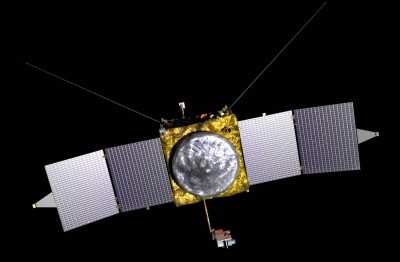Wed, Sep 28, 2011
Next Phase Is Static Load Testing Simulating Launch
The primary structure of NASA's MAVEN spacecraft has been
completed at Lockheed Martin's Space Systems Company facility near
Denver. The Mars Atmosphere And Volatile EvolutioN (MAVEN)
spacecraft is scheduled to launch in November 2013 and will be the
first mission devoted to understanding the Martian upper
atmosphere.
LMC Photo

In this photo taken on September 8, technicians from Lockheed
Martin are inspecting the MAVEN primary structure following its
recent completion at the company's Composites Lab. The primary
structure is cube shaped at 7.5 feet x 7.5 feet x 6.5 feet high.
Built out of composite panels comprised of aluminum honeycomb
sandwiched between graphite composite face sheets, the entire
structure only weighs 275 pounds. At the center of the structure is
the 4.25 feet diameter core cylinder that encloses the hydrazine
propellant tank and serves as the primary vertical load-bearing
structure. The large tank will hold approximately 3,615 pounds of
fuel.
"It's always a significant milestone when the project moves from
a paper design to real hardware and software," said Guy
Beutelschies, MAVEN program manager at Lockheed Martin Space
Systems Company. "Seeing the core structure reinforces the fact
that MAVEN is no longer just a set of ideas that scientists and
engineers have come up with, it is starting to become a
spacecraft." In mid October, the structure will be moved to
Lockheed Martin's Structures Test Lab and undergo static load
testing, which simulates and tests the many dynamic loads the
spacecraft will experience during launch.
Despite the primary structure's light weight, it's designed to
support the entire spacecraft mass during the launch, which applies
an equivalent axial force at the launch vehicle interface of
approximately 61,000 pounds when including accelerations up to 6
Gs. After completion of the static tests, the structure will be
moved into a clean room to start propulsion subsystem integration.
The Assembly, Test and Launch Operations (ATLO) phase begins July
2012.
NASA Artist's Concept

"There's still a lot of work to go before we have the complete
spacecraft, but this is a major step in getting us to the launch
pad in two years. All of the team's hard work now will pay off when
we get to Mars and see the science results," said Bruce Jakosky,
MAVEN principal investigator from the Laboratory for Atmospheric
and Space Physics at the University of Colorado (CU/LASP) at
Boulder.
The goal of MAVEN is to determine the role that loss of
atmospheric gas to space played in changing the Martian climate
through time. MAVEN will determine how much of the Martian
atmosphere has been lost over time by measuring the current rate of
escape to space and gathering enough information about the relevant
processes to allow extrapolation backward in time.
More News
From 2023 (YouTube Version): Legacy of a Titan Robert (Bob) Anderson Hoover was a fighter pilot, test pilot, flight instructor, and air show superstar. More so, Bob Hoover was an i>[...]
Get The Latest in Aviation News NOW on Instagram Are you on Instagram yet? It's been around for a few years, quietly picking up traction mostly thanks to everybody's new obsession >[...]
Aero Linx: B-52H Stratofortress The B-52H Stratofortress is a long-range, heavy bomber that can perform a variety of missions. The bomber is capable of flying at high subsonic spee>[...]
Altimeter Setting The barometric pressure reading used to adjust a pressure altimeter for variations in existing atmospheric pressure or to the standard altimeter setting (29.92).>[...]
"Knowing that we play an active part in bettering people's lives is extremely rewarding. My team and I are very thankful for the opportunity to be here and to help in any way we ca>[...]
 Classic Aero-TV: Remembering Bob Hoover
Classic Aero-TV: Remembering Bob Hoover ANN FAQ: Follow Us On Instagram!
ANN FAQ: Follow Us On Instagram! ANN's Daily Aero-Linx (05.15.24)
ANN's Daily Aero-Linx (05.15.24) ANN's Daily Aero-Term (05.15.24):Altimeter Setting
ANN's Daily Aero-Term (05.15.24):Altimeter Setting Aero-News: Quote of the Day (05.16.24)
Aero-News: Quote of the Day (05.16.24)




